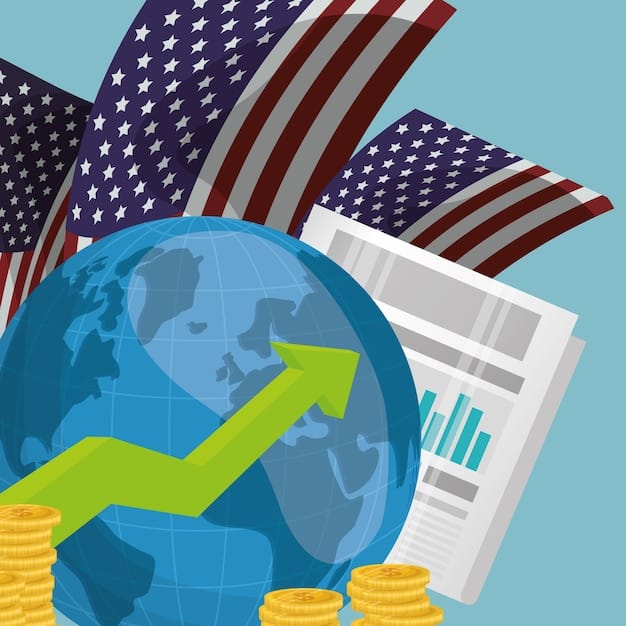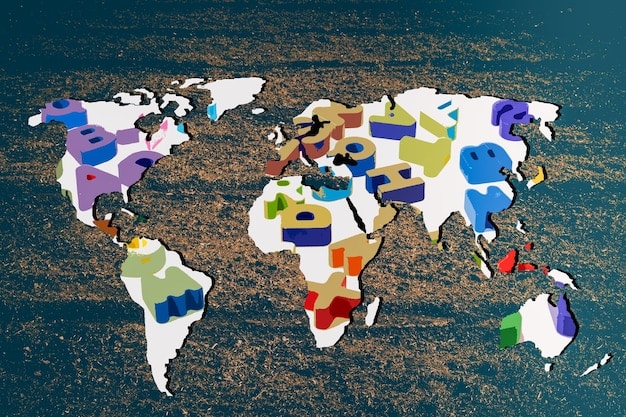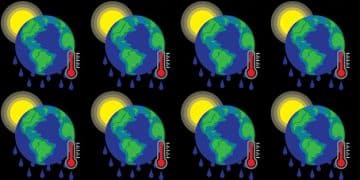US Foreign Aid in 2025: Key Beneficiaries and Strategic Goals

US Foreign Aid in 2025: Which Countries Will Benefit and What Are the Strategic Goals? In 2025, US foreign aid will likely focus on countries facing humanitarian crises, political instability, and economic challenges, aligning with strategic goals of promoting global stability, fostering economic growth, and advancing US national security interests.
Understanding US Foreign Aid in 2025: Which Countries Will Benefit and What Are the Strategic Goals? is crucial for assessing global development, security, and diplomatic relationships. Let’s explore what to expect in the coming year.
US Foreign Aid: An Overview
United States foreign aid is a critical tool used to advance various objectives on the global stage. It encompasses a wide range of programs, including humanitarian assistance, economic development, and security cooperation. Understanding its role is essential to grasp its future.
Historical Context
US foreign aid has evolved significantly over the decades. From the Marshall Plan after World War II to modern initiatives addressing global health and climate change, its scope and focus have adapted to changing global needs and US interests. Throughout history, it has been used to promote stability, foster economic growth, and counter threats.
Current Priorities
Currently, US foreign aid priorities are shaped by a complex interplay of factors. These encompass national security concerns, humanitarian imperatives, and economic considerations. Key areas of focus include:
- Global Health: Combating infectious diseases and improving healthcare systems.
- Economic Development: Promoting sustainable growth and reducing poverty.
- Security Assistance: Strengthening allies and addressing security threats.
These priorities reflect the multifaceted nature of US foreign policy.

In conclusion, US foreign aid is a multifaceted instrument used to achieve various strategic goals, from promoting global health and economic development to bolstering security and stability in key regions.
Potential Beneficiary Countries in 2025
Identifying which countries will likely receive the most significant amounts of US foreign aid in 2025 requires analyzing current trends and geopolitical factors. Several regions and nations consistently feature prominently in aid allocations.
Africa
Sub-Saharan Africa is a major recipient of US foreign aid. Countries like Nigeria, Kenya, and Ethiopia receive assistance targeted at health, education, and economic development. Programs often focus on combating diseases like HIV/AIDS, malaria, and supporting agricultural productivity.
Middle East
The Middle East remains a critical region for US foreign aid. Countries such as Egypt, Jordan, and Iraq receive substantial support, often tied to security cooperation and counterterrorism efforts. Humanitarian assistance also plays a significant role, particularly in conflict zones like Syria and Yemen.
Asia
In Asia, countries like Afghanistan, Pakistan, and Vietnam are significant beneficiaries. Aid is directed towards various sectors, including infrastructure development, education, and governance reforms. Emphasis is also placed on countering extremism and promoting regional stability.
Latin America
Countries in Latin America, such as Colombia, Honduras, and Guatemala, receive US foreign aid aimed at addressing issues like drug trafficking, crime, and poverty reduction. Programs often focus on strengthening law enforcement and promoting economic opportunities for vulnerable populations.
In summary, the potential beneficiary countries in 2025 span several regions, with Africa, the Middle East, Asia and Latin America receiving a considerable amount of support.
Strategic Goals of US Foreign Aid
US foreign aid is not merely philanthropic; it serves strategic goals that align with US national interests. These goals are diverse and often interconnected, reflecting the complex challenges of the 21st century.

Promoting Global Stability
One of the primary goals of US foreign aid is to promote global stability. By providing assistance to countries facing conflict, political instability, or economic crises, the US aims to prevent these issues from escalating and threatening international security. Aid programs often support peacebuilding efforts, democratic governance, and the rule of law.
Fostering Economic Growth
Economic development is another key objective. US foreign aid supports initiatives that promote sustainable economic growth, create jobs, and reduce poverty. This includes investments in infrastructure, education, and entrepreneurship, which can help recipient countries become more self-sufficient and contribute to the global economy.
Advancing US National Security Interests
US foreign aid is also used to advance US national security interests. Security assistance programs help strengthen allies, counter terrorism, and address other security threats. This can include providing military training, equipment, and intelligence support to partner nations. Additionally, aid is often used to promote diplomatic relationships and build alliances.
Understanding the strategic goals of US foreign aid reveals that it is not only about helping others but also about advancing US interests in a complex and interconnected world.
Factors Influencing Aid Allocation
Several factors influence how the US decides to allocate foreign aid. These factors range from geopolitical considerations to domestic political pressures. Understanding these influences is crucial for predicting future aid trends.
Geopolitical Considerations
Geopolitical factors play a significant role in aid allocation. The US often prioritizes countries that are strategically important, either because of their location, their role in regional security, or their relationship with other major powers. For example, countries bordering potential adversaries or those crucial to counterterrorism efforts often receive significant aid.
- Strategic importance of the location.
- The country’s role in regional security.
- Relationships with other major powers.
Humanitarian Needs
Humanitarian needs are another critical factor. The US provides substantial aid to countries facing natural disasters, famines, or other humanitarian crises. This reflects both a moral imperative and a strategic interest in preventing instability and mitigating suffering.
Political and Economic Conditions
Political and economic conditions in recipient countries also influence aid allocation. The US often favors countries that are committed to democratic governance, human rights, and economic reforms. Aid is often conditioned on progress in these areas, reflecting a desire to promote positive change. On the other hand, economic reforms can foster growth and stability, aligning with US strategic goals.
In conclusion, understanding the various factors that influence aid allocation provides insight into the complex decision-making processes that shape US foreign policy.
Potential Shifts in Priorities
Looking ahead to 2025, several potential shifts in US foreign aid priorities could occur. These shifts may be driven by changes in the global landscape, new administrations, or evolving US interests.
Impact of Emerging Global Challenges
Emerging global challenges, such as climate change and pandemics, are likely to influence future aid priorities. The US may increase its investments in climate resilience, renewable energy, and global health security to address these growing threats. Similarly, pandemics could lead to greater support for vaccine development, healthcare system strengthening, and disease surveillance.
Changes in US Foreign Policy
Changes in US foreign policy can also lead to shifts in aid priorities. A new administration may have different priorities and approaches to foreign aid, leading to adjustments in which countries and sectors receive the most support. These shifts can reflect changes in diplomatic relationships, security concerns, or economic strategies.
Budgetary Constraints
Budgetary constraints can also impact aid allocation. If the US faces economic challenges or rising debt levels, it may be forced to reduce its foreign aid budget, leading to difficult choices about which programs and countries to prioritize. This could result in a more targeted approach, focusing on areas where US interests are most directly affected.
Anticipating potential shifts in priorities is essential for understanding the future trajectory of US foreign aid and its impact on global development and security.
The Role of International Organizations
International organizations play a significant role in the implementation and effectiveness of US foreign aid. These organizations, such as the United Nations, the World Bank, and various NGOs, often partner with the US to deliver aid and achieve shared goals.
Collaboration with the UN
The United Nations is a key partner in US foreign aid efforts. The US works with various UN agencies, such as the World Health Organization (WHO) and the United Nations Development Programme (UNDP), to address global health, development, and humanitarian challenges. These partnerships leverage the UN’s global reach and expertise.
Partnerships with the World Bank
The World Bank is another important partner. The US collaborates with the World Bank on projects aimed at promoting economic growth, reducing poverty, and improving living standards in developing countries. These partnerships often involve providing financial resources, technical assistance, and policy advice.
Cooperation with NGOs
Non-governmental organizations (NGOs) are essential partners in delivering aid at the grassroots level. The US often contracts with NGOs to implement aid programs in various sectors, including health, education, and agriculture. These partnerships leverage the NGOs’ local knowledge and community connections. NGOs often have a better understanding of local needs and can adapt programs to fit specific contexts, enhancing their effectiveness, contributing to the achievement of US foreign aid objectives.
The collaborative relationships between the US and international organizations are crucial for maximizing the impact of foreign aid and addressing complex global challenges.
| Key Point | Brief Description |
|---|---|
| 🌍 Beneficiary Regions | Africa, Middle East, Asia, and Latin America. |
| 🎯 Strategic Goals | Promoting global stability, fostering economic growth, and advancing US national security. |
| ⚖️ Factors Influencing Allocation | Geopolitical factors, humanitarian needs, and political/economic conditions. |
| 🤝 Role of International Organizations | Partnerships with UN, World Bank, and NGOs. |
FAQ
▼
The primary goal is to promote global stability, foster economic growth, and advance US national security interests through various assistance programs.
▼
Major recipient regions include Sub-Saharan Africa, the Middle East, Asia, and Latin America, each receiving aid tailored to their specific needs.
▼
Geopolitical factors significantly influence aid allocation, with the US prioritizing countries strategically important for regional security and counterterrorism efforts.
▼
International organizations like the UN, World Bank, and NGOs are crucial partners, helping to implement aid programs and achieve shared global objectives.
▼
Potential shifts include increased focus on climate change, global health security, and adjustments based on new administrations’ foreign policy changes and budgetary constraints.
Conclusion
In summary, US foreign aid in 2025 will likely continue to prioritize regions facing significant challenges, with strategic goals that align with US national interests and global stability. Understanding the factors influencing aid allocation and the role of international organizations provides a comprehensive view of how US foreign aid operates and its potential impact on the world.





